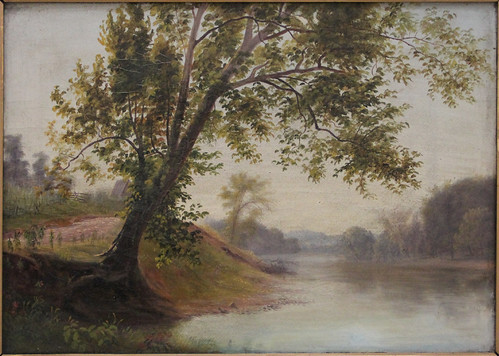
The Great Miami River, an oil painting (circa 1850) by either Elizabeth Frankenstein or Godfrey N. Frankenstein. Image courtesy of the Clark County Historical Society. Photo by Sandy Bialik.
Sometimes, when an image is good enough, or when it simply speaks to the people of a given place and time, it takes on a life of its own. Such is the case with this painting, by either Elizabeth Frankenstein or her brother, Godfrey Nicholas Frankenstein.
The painting, The Great Miami River (circa 1850) depicts a scene near Cleves, Ohio. Cleves is a town in the very southwest corner of the state, about seven and a half miles from where the Great Miami empties into the Ohio River.

Detail, Map of Hamilton County, Ohio, a print (1856) by A.W. Gilbert. Used courtesy of the Library of Congress.
Based on the information available, Frankenstein's painting appears to have been made in the location shown on this detail of Gilbert's 1856 Map of Hamilton County, Ohio. It's the only place in the vicinity of Cleves where the road comes close enough to the water and one has an unobstructed straight view down the river. The view is looking approximately west, as shown by the green lines drawn on the map.
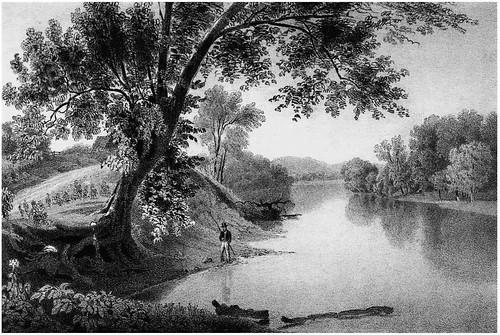
View on the Great Miami, Near North Bend, a print (1851) by Onken's Lithography, after a painting by Godfrey N. Frankenstein. Published in Western Scenery; or, Land and River, Hill and Dale, In the Mississippi Valley. (1851) by William Wells. Used courtesy of the Public Library of Cincinnati and Hamilton County.
The image was reproduced by Onken's Lithography in this 1851 print, with the additon of a man fishing.
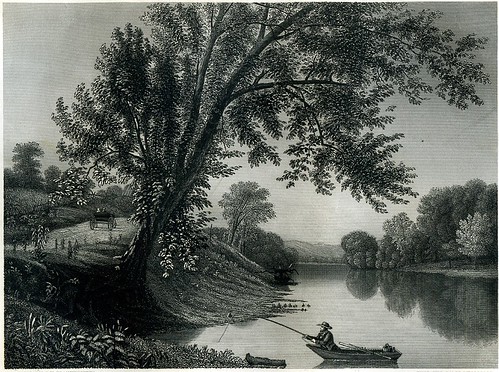
View On The Great Miami (Near Cleves, O.), an engraving (April, 1857) by William Wellstood, after a painting by Godfrey N. Frankenstein. Published in The Ladies Repository, April, 1857. Used courtesy of The Philadelphia Print Shop.
It was reproduced again in the April, 1857 issue of the Ladies Repository, which was published in Cincinnati. In this image, the man fishing is in a boat, and a cart has been added on the road.
![Mill Creek Near Cincinnati / [less likely ] Great Miami River near Cleves](http://farm8.staticflickr.com/7265/7456187278_6bd4aec4a3.jpg)
Mill Creek Near Cincinnati / Great Miami River near Cleves, an oil painting (1847) by Godfrey Nicholas Frankenstein. Used courtesy of Cincinnati Art Galleries. Reproduced from Panorama of Cincinnati Art II, 1850-1950 by Cincinnati Art Galleries.
To help confuse things, another painting (1847) by Godfrey N. Frankenstein has sometimes been listed with the title Great Miami River near Cleves. At others, it was listed as Mill Creek at Cincinnati. A print of the subject was published with the title Mill Creek at Cincinnati giving credence to that name. Note that the body of water in this painting is much shallower than in the other images.
I'm unsure as to whether this depicts the Great Miami River or Mill Creek. Whichever case, it's not the scene depicted in the lead painting.
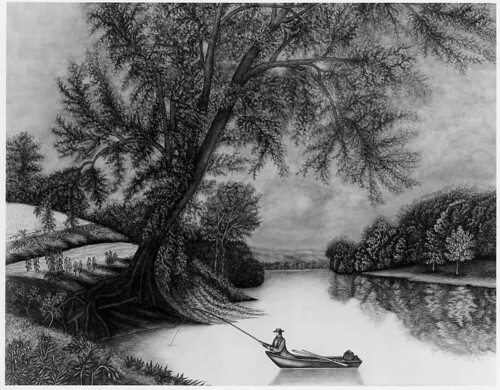
Fisherman on the Harwinton, a drawing / watercolor painting (1857 or later). Used courtesy of the Museum of Fine Arts, Boston.
Imagine my surprise when I saw this image, Fisherman on the Harwinton, in the M. & M. Karolik collection of American water colors & drawings, 1800-1875. A quick search revealed Harwinton to be in Connecticut.
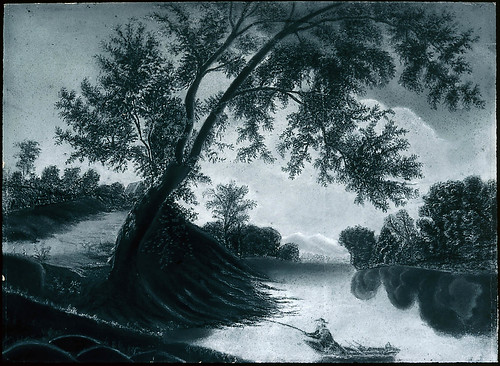
Fisherman on the Harwinton, a chalk drawing (1857 or later). Used courtesy of the Museum of Fine Arts, Boston.
I went to the online catalog of the Museum of Fine Arts, Boston, looking for more information. I was again surprised by a second work titled Fisherman on the Harwinton. These two works are said to depict a scene "near Litchfield, Connecticut". (Museum of Fine Arts, Boston, M. & M. Karolik collection of American water colors & drawings, 1800-1875, vol. 2, p. 137-139.)
I'm sure that the two works titled Fisherman on the Harwinton are based on the print published in The Ladies Repository, in April, 1857. What, then, made someone think that they were of a scene in Connecticut?
I suspect that oral tradition held that one of the works depicted a scene near Harwinton, Connecticut. This somehow (as oral tradition tends to do) became a scene on the Harwinton. When another work with an identical composition came into the Museum of Fine Arts, Boston's collection, it was obvious that it was after the same original - and so received the same title.
Out of curiousity, I checked the two gazetteers from that period that I could readily locate - John Hayward's 1839 New England Gazetteer and John Chauncey Pease and John Milton Niles' 1819 Gazetteer of the States of Connecticut and Rhode-Island. While both listed Harwinton as a place name, neither listed it as the name of any sort of body of water.




No comments:
Post a Comment